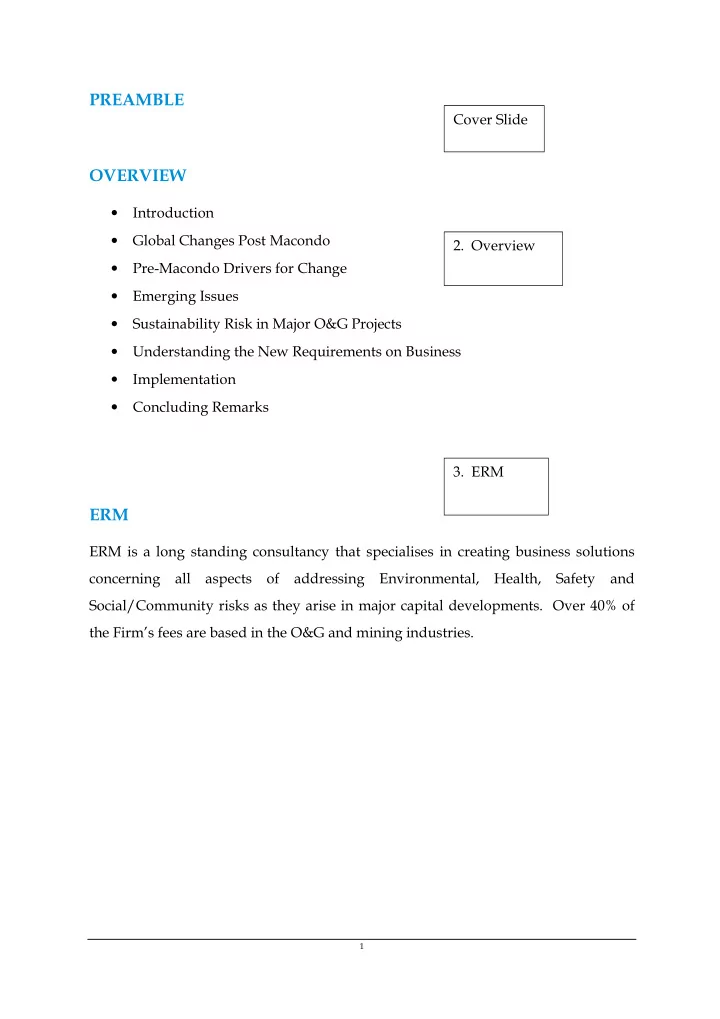

� PREAMBLE� Cover�Slide� � OVERVIEW� • Introduction�� • Global�Changes�Post�Macondo� 2.��Overview� • Pre�Macondo�Drivers�for�Change� • Emerging�Issues� • Sustainability�Risk�in�Major�O&G�Projects� • Understanding�the�New�Requirements�on�Business� • Implementation� • Concluding�Remarks� � 3.��ERM� � ERM� ERM�is�a�long� standing�consultancy�that�specialises�in�creating�business� solutions� concerning� all� aspects� of� addressing� Environmental,� Health,� Safety� and� Social/Community�risks�as�they�arise�in�major�capital�developments.��Over�40%�of� the�Firm’s�fees�are�based�in�the�O&G�and�mining�industries.� � 1� �
� 1) �INTRODUCTION� 4.��DH� � On�April�20 th �2010,�a�blowout�occurred�at�BP’s�MC252�well�followed�by�an�explosion� on�the�Deepwater�Horizon�exploration�rig�and�its�subsequent�loss.��Eleven�people� lost�their�life�and�in�the�ensuring�three�months�c.�650,000�tonnes�of�oil�was�released� into�the�deepwater�Gulf�of�Mexico. � � 5.�GOM� 6.�UK� � The�resultant�slick�stretched�from�the�equivalent�of�Rotterdam�to�beyond�Swansea� and�from�Southampton�to�beyond�Birmingham.��The�estimated�costs�for�capping�the� well,� oil� spill� response� and� community� compensation� is� estimated� at� somewhere� between�$20�30bn. � � � The�distinctive�features�of�this�spill�are�the�size�(5�million�bbls),�duration�(15�weeks),� the� sensitivity� of� its� location� (major� source� for� the� US� seafood� and� recreation� industries),�the�press�coverage,�loss�of�life�and�injury�(28)�and�business�interruption� both�offshore�and�onshore.� 7.��CNN� � The�Macondo�Deepwater�Horizon�disaster�was�not�new�to�the�industry.��What�was� new� was� the� scale� of� the� resultant� impact� –� social,� environmental� and� ultimately� financial.��Not�unlike�the�9/11�NYC�terrorist�disaster,�it�had�occurred�previously�at� much� lesser� scale,� but� we� were� blind� to� the� possible� catastrophic� impact� of� the� combination� of� both� advancing� technology� frontiers� and� human� behaviour� –� technical�and�non�technical�risk.� � � 2� �
� 2) �GLOBAL�CHANGES�–�A�POST�MACONDO�WORLD� 8.��Overview� � The� Macondo� disaster� has� precipitated� a� wide� range� of� both� direct� and� indirect� changes�in�the�global�O&G�business.��The�playing�field�for�upstream�exploration�and� production�developments�has�changed�forever.� � 9.�Post�Macondo� The�direct�changes�include:� Issues� � ������ • Increase�time�for�Permits�approval:�50�200�days�(de�facto�moratorium)� • Increase�of�>25%�in�rig�time�to�drill�to�comply�with�new�regulations� • Reduced�GOM�production�(400,000�bpd�→�60,000�bpd�(Nov�2010)�→�100,000� bpd�(2011)� • Well�design���construction�optimised�for�compliance,�not�production� • Rig�availability�decrease�(46�Ap’10�→�12�Dec�‘10�→�34�Mid�‘11)� • Increased� oil� spill� response� prep� costs� ($1bn� Marine� Well� Containment� Company)� ����������� Premium�Increases� • Rigs�in�shallow�water�� I�15�20%� • Deepwater�operations�� I�25�30%� • Deepwater�drilling�� I�100%� � ������� • Ban�on�GOM�drilling�→�October�2010� • Continuing�ban�on�Atlantic�and�East�GOM�(OCS)� • Alaska?� 3� �
• Chevron�in�Santos�Basin�(Brasil)?� � ����������� • Drilling�Safety�Rule�(BOEMRE)� � (US)� • The�Workplace�Safety�Rule� � � (US)� • OSPRAG�Review� � � � � (UK)� • Proposed�EU�Regulation�(Oct�2011)�� (Europe)� � ������������������� • Reiterating�the�GOM�Drilling�Moratorium�(April�October�2010)� • French�and�New�York�state�Fracking�Moratoriums� • Increased�Liability�Caps� o EU�$120m�→�$250m� o US��???� • Difficulty�for�smaller�operators� � The�preceding�global�changes�as�a�direct�result�of�the�Macondo�incident�are�clearly� considerable�and�wide�ranging.��The�role�played�by�NTRs�as�opposed�to�technical� risks�as�causes�of�the�incident�are�more�difficult�to�determine.��What�perhaps�is�more� pertinent� here� is� once� the� blow�out� had� occurred,� the� NTR� issues� significantly� impacted�the�scale�of�the�damages�incurred�by�BP.� � � � � 4� �
� 10.�Overview� 3)��PRE�MACONDO�DRIVERS�FOR�CHANGE� � Despite�the�headline�grabbing�nature�of�the�Macondo�Deepwater�Horizon�disaster� and� the� reported� knock�on� effect� on� global� boardroom� thinking� regarding� risk� management� in� the� O&G� sector,� there� had� been� a� lot� of� activity� and� momentum� created� in� the� industry� towards� long�term� sustainable� operation� for� some� time� before�Macondo.� � 11.�Pre�Macondo� � � A� number� of� issues� had� been� driving� this� thinking� in� the� second� half� of� the� last� decade�–�not�necessarily�catastrophic�events,�but�equally�critical�to�the�future�of�the� industry.��The�more�macroeconomic�of�these�include:� • Future�Reserves�Replacement� • Oil�Price�Escalation� • Global�Financial�Crisis�(2008)� � All� of� these� perturbations� have� caused� the� industry� to� question� how� they� can� continue�to�operate�in�a�sustainable�manner�–�we�have�increasingly�been�forced�to� ask�the�question,� “How�well�prepared�is�our�business�to�operate�in�an�environment� of�increasing�regulation,�risk�uncertainty�and�stakeholder�scrutiny?”�� � It�is�insightful�to�look�further�into�the�key�factors�or�challenges�that�have�created�this� change�in�the�industry,�especially�as�they�relate�to�the�search�for�replacement/future� hydrocarbons.��It�is�also�useful�to�examine�the�roles�of�both�technical�risks�and�NTRs� and� in� particular� their� interconnectedness.� � Addressing� NTRs� often� involves� technical�solutions,�and�similarly�technical�risks�are�often�put�forward�in�the�form�of� NTRs�to�enhance�the�emotive�component.� 5� �
� 12.�Sov�Oil� � �� ↓� 13.�Easy�Oil� SOVEREIGN�OIL� � Reserves� replacement� for� IOC’s� has� been� the� elephant� in� the� room� since� the� 90s.�� Roughly�70%�of�the�world’s�future�reserves�are�under�sovereign�control�of�national� oil� companies� (NOCs)� and� usually� accessed� by� formation� of� minority� JVs.� � The� valuation�of�IOCs�for�some�time�has�been�based�on�replacement�ratio�of�reserves.� � The�rapid�oil�price�escalation�to�$150�pb�in�second�half�of�the�decade�saw�short�term� windfall�profits�being�made�by�the�industry�but�at�the�same�time�a�rapid�escalation� in�costs�of�materials,�(i.e.�steel,�rigs�etc.)�which�caused�the�cancellation�or�delay�of� many�projects.��This�trend�was�further�exacerbated�by�the�transition�from�so�called� “easy� oil”� to� “socially� difficult� oil”� where� non�technical� factors� were� having� significant�impact�on�delays�and�subsequent�costs�of�these�emerging�mega�projects.�� The�scenario�is�best�typified�by�Shell’s�development�of�the�Sakhalin�II�project�where� costs� blew� out� from� about� $5bn� to� more� than� $20bn,� ultimately� resulting� in� Shell� losing�their�controlling�interest�in�the�project�to�the�Russian�NOC�Gazprom.��� The� ironic� fact� about� this� debacle� for� Shell� is� that� the� Russian� Government� used� environmental� non�compliance� issues� or� NTRs� to� force� Shell� to� forfeit� control� –� issues�that�the�local�industry�almost�universally�never�are�in�compliance.� This�was�followed�by�the�GFC�in�2008�where�global�demand�in�the�industry�receded� causing� significant� falls� in� O&G� prices� and� putting� further� pressure� on� project� sanctions.� � � 6� �
Recommend
More recommend